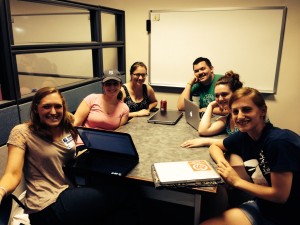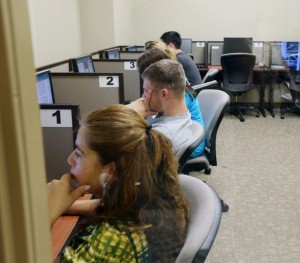This semester, the Networkers have studied digital collaboration tools, specifically WordPress.com. Our goal was help other English Professors to implement WordPress blogging into their classrooms, and then to serve as resources to help improve their experience using the tool. Throughout that process, we created our own WordPress help page and used other tools such as Google Docs, Forms on Google Docs, and Doodle. We also researched other means for collaboration such as Prezi, Commons in a Box and Comment Press. We learned a lot this semester about the typical problems and fears English professors face in implementing blogging into their classrooms, and how to improve upon and enhance this experience.
Google Docs and blogging are two online tools that we used consistently in this class throughout the semester. Google Docs was incredibly useful in collaborating with group members on our projects. Not only were we able to collaborate with our own group members, but we were also able to collaborate with the rest of the class as well as Dr. Schacht. Dr. Schacht was able to post readings and assignments that he wanted us to do, and we could go on in class or outside of class and have access to them. Dr. Schacht was also able to go onto the Google Doc on his own time and check on the progress each group was making in their projects. Google Docs is a very useful tool for online communication in a class, or if trying to put together a project or presentation in a group. However, there are elements that other sites like WordPress are more suited for, for example blogging.
Blogging is something that is now being used in many classroom settings, as it is easily accessible to students. One positive aspect of blogging is that it gives students a chance to express their ideas in a place for others to read them. Another positive of blogging is that you can share things, like articles and media that connect with class discussions and enhance the material being taught in class. Blogging is an especially good tool for people who might be less outgoing and not likely to share their ideas in class. Blogs give them a place to feel comfortable expressing their ideas and opinions. One negative aspect of blogging is that it can be used as a substitute to face to face conversations and discussions. Blogging is a great form of communication as long as it is used in conjunction with class discussion, and used as a way to spark new ideas or reinforce what was taught and discussed in the classroom.
In order to come up with our manual for the class blog, our group explored many different avenues. At first we thought a PowerPoint or a Prezi would be an easy way of showing the general set up of the site, but we soon figured that that wasn’t beneficial for everyone. We also toyed with the idea of having a running document where anyone would have access to view, but again this seemed too large and messy. Users would have to go through so many different posts to get to their question and that could get too confusing and convoluted. To keep with the theme of the class a website seemed like the best idea as it would allow us to tag posts so that the users can use this with ease to find a specific post. Once we realized that wordpress was the best avenue as it looks and feels much like the SUNYGeneseoEnglish wordpress, we had to decide between a .com or a .org platform. As the school uses a .org we really wanted to use this, but in order to set up a blog we would have to pay for a subscription, and we didn’t feel like that was necessary when the .com was free for use to use for the small amount of posts we would have.
After setting up the page, we had to make it work for our purposes. We hit some roadblocks here. We originally each created posts about different topics (adding media, turning off email setting, etc) and then put them into different categories. Some of the posts also included information about who we were and how to contact us. It quickly became clear that those important posts were getting lost in a set-up in which most recent posts were first. So, we created 4 static pages: Home, Posts, Who We Are/How to Contact Us, and About English @ SUNY Geneseo. We also had to rearrange our widgets in the Posts Page to make “Categories” appear above “Recent Posts.” This made the site easier to navigate. We switched the theme to Hemingway Rewritten and put an image at the top of the trees in front of Welles in the Spring. The page now looks very aesthetically pleasing. Now we’ve decided to switch the site over to a WordPress.org page connected to sunygeneseoenglish.org. To do this, we’ll probably have to change the page to xml and upload it to the .org page.
Throughout the journey of creating a help center we have faced various challenges that have encouraged us to re-route our plan of attack. We originally thought that sending a mass email out to our classmates, asking for further information on what they wanted to know more about, would be a good idea. We were not suspecting to have zero feedback. This had set us back slightly. We had created a wordpress filled with general information on blogging, although this idea was structured around feedback. Having that lack of feedback kept our idea from aiding specific information that was sought upon. This challenge of not being able to reach out to others enforced our small group to put ourselves in other student’s shoes in trying to meet the suspected needs we believe they would ask. This was the most troubling challenge we had to face. Although slight challenges have set our project back at times, the strength of our group had helped to overcome the difficulties and restructure our plan to better meet the needs of our website and the students using it.
This semester, I (Michael) have been immersed in the world of blogging. My SUNYGeneseoEnglish WordPress account is not only connected with the Digital Humanities, but also with The Practice of Writing with Dr. Paku, and Film Talk with Professor Ed Gillin. The three courses are all fundamentally different, and because of this, each class’ use of the blog is also different. Being in the Networker group has forced me to consider how the blog is used in other classes, and actually being in those classes makes me an expert. Dr. Paku’s class, The Practice of Writing, is composed of nine English Adolescent Education majors. This intimate group focuses on the basics of writing and how to teach writing to students. The class contains a service learning component, and the students spend time actually practicing what they learn in the classroom. At first, Dr. Paku would post a prompt as a blog post, and ask students to post their answers in the comments. While this may keep the posts somewhat organized, people visiting the blog (which is now public), may not think to click on the comments. In order to keep the organization of this blog and make the posts more accessible, we gave the blog a bit of a facelift. We made use of the ability to categorize each post, and then we added widgets on the sidebar that show those different categories. By the end of the course, Dr. Paku would ask us to blog about a topic, and she or I would create a category that everyone was able to choose. For example, after a week of service learning, we all posted about our experiences, and those posts can be easily accessed by clicking on the “Service Learning” category.
On the other hand, Professor Gillin’s class group, Film Talk, has been very straightforward and has not really changed at all, mostly because the original way it was used fits the class perfectly. Every week the class watched a movie and two students are required to do a film review on that movie. These students do not post on the blog like Dr. Paku’s students do, but instead, create a topic in the forum and post their review there. With this format, students are easily able to comment on the review and see the posts in a collected thread. A majority of these forum topics have at least three different “voices” in each. These two classes went about using the SUNYGeneseoEnglish WordPress very differently, but were able to tailor the site to their needs. With the help of the Networkers group, I think that even more English courses will be able to figure out the best ways to take advantage of using WordPress.
We also worked throughout the semester with Dr. Doggett’s class, assisting them with using the blog for their Irish Studies class. Through our work with them, we learned about a project they’re working on in anticipation of the Alumni Summer Trip to Ireland. They were looking to create some sort of site or app that people on the trip could use to communicate and get facts about different locations in Ireland. It’s going to be an ongoing project, and we were able to help them get started.
We met with Dr. Doggett and he told us that the idea was that while visiting certain places, they should be able to open this app, find the page that corresponds to their location, and access pictures and facts. He also wanted an outlet for people going on the tour to connect and discuss flights, transportation, and other questions they might have before the trip. In addition, he said that there should be a place for the latest news announcements on the main page, and a separate page for FAQ’s. Basically it is going to be a go-to resource for travelers to connect and get information both before and during their trip.
A challenge of this project is that while many people have smartphones, not all of the places they visit will have WiFi. Because of high international data costs, we needed to create something they could download and access offline. We started designing a WordPress site, creating sections and pages for the topics that needed to be covered. The group discussion will be better suited to a forum, so we decided there should be a group on the SUNY Geneseo English page for them too. While on the trip, Dr. Doggett will be able to post about the latest information they need to know, and we got an RSS feed on the main page so it can be conveniently seen. Our hope is that there will ultimately be an app that will allow users to download the whole site to their phones, making it accessible without WiFi.
Working on this project was a nice way to take an in-depth look behind the scenes of WordPress, which we’ve been using all semester. Seeing all the different options was overwhelming at times, but this makes it possible to customize the site in a way that meets our needs. Getting the Ireland site set up was exciting because it sets a precedent for future Ireland trips and other study abroad groups. We think it’s going to be a really useful tool. If we can make it accessible in Ireland, then other courses should be encouraged to create their own sites for their trips as well. Having started off at the beginning of the semester as students who were new to WordPress, we’ve come a long way and have learned what goes into all stages of blogging.

Group Members: Michael Augello (jellyfish), Lindsey Gales (dolphin), Becca Miller (seal), Katelyn Baroody (jellyfish), Chrissy Stellrecht (dolphin), Lyndsay Moore (jellyfish)



